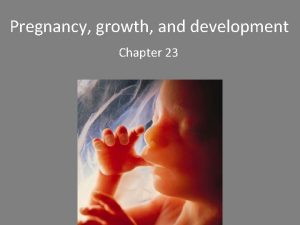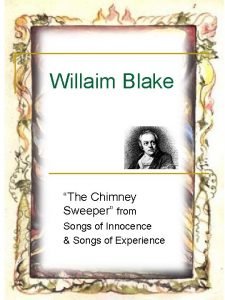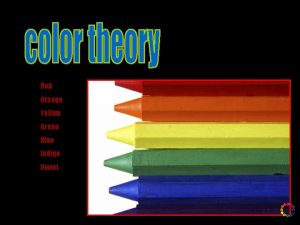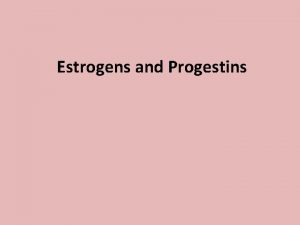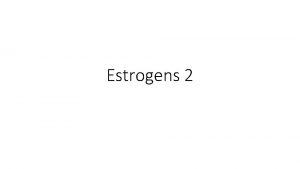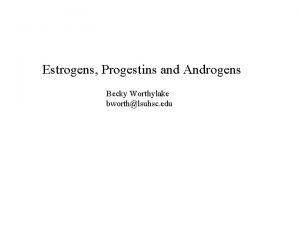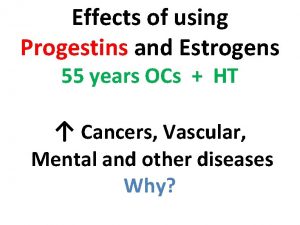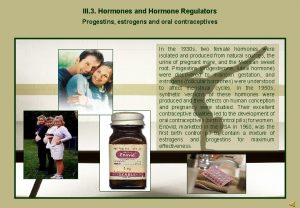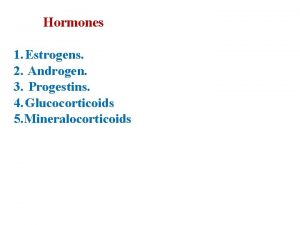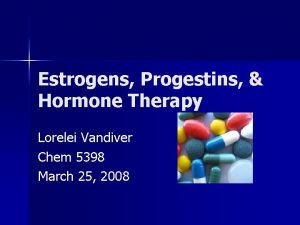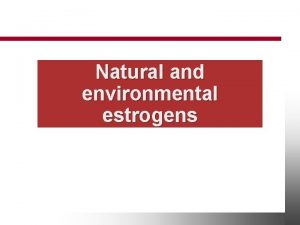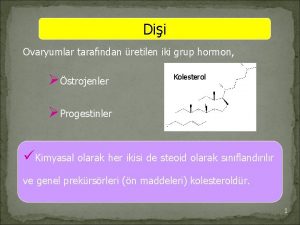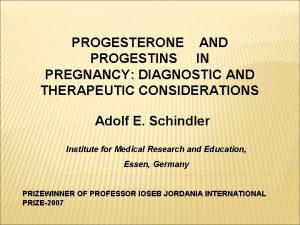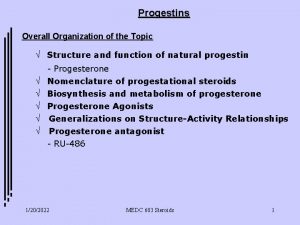Estrogens and Progestins strojenler ve progestinler ok sayda















- Slides: 15

Estrogens and Progestins

• Östrojenler ve progestinler çok sayıda fizyolojik etkileri olan endojen hormonlardır. • Kadınlarda bunlar gelişimsel etkileri, yumurtlamanın kontrolünde yer alan nöroendokrin eylemleri, döllenme ve implantasyon için üreme yolunun döngüsel olarak hazırlanmasını ve mineral, karbonhidrat, protein ve lipit metabolizması üzerindeki büyük eylemleri içerir. • Östrojenlerin erkeklerde kemik, spermatogenez ve davranış üzerindeki etkileri de dahil olmak üzere önemli etkileri vardır. • • Östrojenlerin ve progestinlerin biyosentezi, biyotransformasyonu ve düzenlenmesi iyi bilinmektedir. Her bir hormon için iyi karakterize edilmiş iki reseptör mevcuttur ve reseptörlerin biyolojik aktivitelere hem ligand hem de steroid hormonu ligand durumlarında aracılık ettiğine dair kanıtlar vardır. • • • Estrogens and progestins are endogenous hormones that produce numerous physiological actions. In women, these include developmental effects, neuroendocrine actions involved in the control of ovulation, the cyclical preparation of the reproductive tract for fertilization and implantation, and major actions on mineral, carbohydrate, protein, and lipid metabolism. Estrogens also have important actions in males, including effects on bone, spermatogenesis, and behavior. The biosynthesis, biotransformation, and disposition of estrogens and progestins are well established. Two well-characterized receptors are present for each hormone, and there is evidence that the receptors mediate biological actions in both the unliganded and steroid hormone-liganded states.




• • • Östrojenlerin ve progestinlerin terapötik kullanımı, büyük ölçüde fizyolojik aktivitelerinin uzantılarını yansıtır. Bu ajanların en yaygın kullanımları kadınlarda menopozal hormon tedavisi ve kontrasepsiyonudur, ancak bu iki ortamda kullanılan spesifik bileşikler ve dozajlar önemli ölçüde farklılık gösterir. Östrojen ve progesteron reseptör antagonistleri de mevcuttur. Anti-östrojenlerin ana kullanımları, hormona duyarlı meme kanseri ve kısırlık tedavisidir. Doku seçici agonist veya antagonist aktiviteler sergileyen selektif östrojen reseptör modülatörleri (SERM'ler) meme kanseri ve osteoporozu önlemek için faydalıdır. Anti-progestinlerin ana kullanımı tıbbi düşük için olmuştur, ancak diğer kullanımlar teorik olarak mümkündür The therapeutic use of estrogens and progestins largely reflects extensions of their physiological activities. The most common uses of these agents are menopausal hormone therapy and contraception in women, but the specific compounds and dosages used in these two settings differ substantially. Estrogen- and progesterone-receptor antagonists also are available. The main uses of anti-estrogens are treatment of hormone-responsive breast cancer and infertility. Selective estrogen receptor modulators (SERMs) that display tissue-selective agonist or antagonist activities are useful to prevent breast cancer and osteoporosis. The main use of anti-progestins has been for medical abortion, but other uses are theoretically possible

Chemistry. The most potent naturally occurring estrogen in humans, for both ERα- and ERβ-mediated actions, is 17β-estradiol, followed by estrone and estriol. Each contains a phenolic A ring with a hydroxyl group at carbon 3, and a β-OH or ketone in position 17 of ring D Hem ERα hem de ERβ aracılı eylemler için insanlarda en güçlü doğal olarak oluşan östrojen, 17β-estradiol, ardından estron ve estriol olur.

• Diethylstilbestrol (DES), which is structurally similar to estradiol when viewed in the trans conformation, binds with high affinity to both estrogen receptors and it is as potent as estradiol in most assays but has a much longer t 1/2. • DES no longer has widespread use, but it was important historically as an inexpensive orally active estrogen Trans konformasyonda görüntülendiğinde yapısal olarak estradiole benzeyen dietilstilbestrol (DES), her iki östrojen reseptörüne yüksek afinite ile bağlanır ve çoğu tahlilde estradiol kadar güçlüdür, ancak çok daha uzun bir t 1 / 2'ye sahiptir. DES'in artık yaygın kullanımı yok, ancak tarihsel olarak ucuz bir oral olarak aktif östrojen olarak önemliydi

• • • Nonsteroidal compounds with estrogenic or anti-estrogenic activity—including flavones, isoflavones (e. g. , genistein), and SECTION V HORMONES AND HORMONE ANTAGONISTS coumestan derivatives—occur in plants and fungi. Synthetic agents—including pesticides (e. g. , p, p′ -DDT), plasticizers (e. g. , bisphenol A), and a variety of other industrial chemicals (e. g. , polychlorinated biphenyls)—also have hormonal or antihormonal activity. Although their affinity is relatively weak, their large number, bioaccumulation, and persistence in the environment have raised concerns about their potential toxicity in humans and wildlife. Over-the-counter and prescription preparations containing naturally occurring estrogenlike compounds from plants (i. e. , phytoestrogens) now are available. • HORMONLAR VE HORMONE ANTAGONISTS • Bitkilerde ve mantarlarda, flavonlar, izoflavonlar (örn. , Genistein) ve coumestan türevleri dahil östrojenik veya anti-östrojenik aktiviteye sahip steroid olmayan bileşikler oluşur. Pestisitler (örn. , P-p-DDT), plastikleştiriciler (örn. , Bisfenol A) ve çeşitli diğer endüstriyel kimyasallar (örn. , Poliklorlu bifeniller) dahil olmak üzere sentetik ajanlar da hormonal veya antihormonal aktiviteye sahiptir. Afiniteleri nispeten zayıf olmasına rağmen, çok sayıda, biyoakümülasyonu ve çevrede kalıcılığı, insanlarda ve vahşi yaşamdaki potansiyel toksisiteleri hakkında endişeleri artırmıştır. Bitkilerden (yani, fitoöstrojenler) doğal olarak oluşan östrojen benzeri bileşikler içeren tezgah üstü ve reçeteli preparatlar şimdi mevcuttur (Fitzpatrick, 2003). • • •

• • • Biosynthesis. Steroidal estrogens arise from androstenedione or testosterone (Figure 40– 1) by aromatization of the A ring. • A ubiquitous flavoprotein, NADPH–cytochrome P 450 reductase, also is essential. • Both proteins are localized in the endoplasmic reticulum of ovarian granulosa cells, testicular Sertoli and Leydig cells, adipose stroma, placental syncytiotrophoblasts, preimplantation blastocysts, bone, various brain regions, and many other tissues. • The ovaries are the principal source of circulating estrogen in premenopausal women, with estradiol the main secretory product • • • Biyosentezi. Steroidal östrojenler, A halkasının aromatizasyonuyla androstenedion veya testosterondan ortaya çıkar. Reaksiyon, ko-substratlar olarak nikotinamid adenin dinükleotid fosfat (NADPH) ve moleküler oksijen kullanan aromataz (CYP 19) ile katalize edilir. Her yerde bulunan bir flavoprotein, NADPH-sitokrom P 450 redüktaz da gereklidir. Her iki protein de yumurtalık granüloza hücrelerinin, testiküler Sertoli ve Leydig hücrelerinin, yağ stroma, plasental sinstiotrophoblastlar, preimplantasyon blastosistleri, kemik, çeşitli beyin bölgeleri ve diğer birçok dokunun endoplazmik retikulumunda lokalizedir. Yumurtalıklar premenopozal kadınlarda dolaşımdaki östrojenin ana kaynağıdır, östradiol ana salgı ürünüdür • • The reaction is catalyzed by aromatase (CYP 19) that uses nicotinamide adenine dinucleotide phosphate (NADPH) and molecular oxygen as co-substrates.

Estrogenic effects most often have been attributed to circulating hormones, but locally produced estrogens also may have important actions (Simpson et al. , 2002). For example, estrogens may be produced from androgens by the actions of aromatase or from estrogen conjugates by hydrolysis. Such local production of estrogens could play a causal or promotional role in the development of certain diseases such as breast cancer because mammary tumors contain both aromatase and hydrolytic enzymes. Estrogens also may be produced from androgens via aromatase in the central nervous system (CNS) and other tissues and exert local effects near their production site (e. g. , in bone they affect bone mineral density). The placenta uses fetal dehydroepiandrosterone and its 16α- hydroxyl derivative to produce large amounts of estrone and estriol. Human urine during pregnancy is thus an abundant source of natural estrogens, and pregnant mare’s urine is the source of conjugated equine estrogens, which have been widely used therapeutically for many years Östrojenik etkiler çoğunlukla dolaşımdaki hormonlara bağlanır, ancak lokal olarak üretilen östrojenlerin de önemli etkileri olabilir. Örneğin, östrojenler, aromatazın etkisiyle androjenlerden veya hidroliz yoluyla östrojen konjugatlarından üretilebilir. Bu tür lokal östrojen üretimi, meme kanseri gibi bazı hastalıkların gelişiminde nedensel veya tanıtımsal bir rol oynayabilir, çünkü meme tümörleri hem aromataz hem de hidrolitik enzimler içerir. Östrojenler ayrıca merkezi sinir sistemi (CNS) ve diğer dokulardaki aromataz yoluyla androjenlerden üretilebilir ve üretim alanlarının yakınında lokal etkiler gösterebilir (örneğin kemikte kemik mineral yoğunluğunu etkiler). Plasenta, büyük miktarlarda estron ve estriol üretmek için fetal dehidroepiandrosteron ve onun 16 a-hidroksil türevini kullanır. Bu nedenle hamilelik sırasında insan idrarı bol miktarda doğal östrojen kaynağıdır ve hamile kısrak idrarı, uzun yıllardır terapötik olarak yaygın olarak kullanılan konjuge at estrojenlerinin kaynağıdır.

Physiological and Pharmacological Actions Developmental Actions. Estrogens are largely responsible for pubertal changes in girls and secondary sexual characteristics. They cause growth and development of the vagina, uterus, and fallopian tubes, and contribute to breast enlargement. They also contribute to molding the body contours, shaping the skeleton, and causing the pubertal growth spurt of the long bones and epiphyseal closure. Growth of axillary and pubic hair, pigmentation of the genital region, and the regional pigmentation of the nipples and areolae that occur after the first trimester of pregnancy are also estrogenic actions. Androgens may also play a secondary role in female sexual development. • Fizyolojik ve Farmakolojik Etkileri. • • • Östrojenler, kadınlarda pubertal değişikliklerden ve ikincil cinsel özelliklerden büyük ölçüde sorumludur. Vajina, uterus ve fallop tüplerinin büyümesine ve gelişmesine neden olurlar ve meme genişlemesine katkıda bulunurlar. Ayrıca vücut hatlarını şekillendirmeye, iskeleti şekillendirmeye ve uzun kemiklerin ve epifiz kapanmasının pubertal büyümesine neden olmasına katkıda bulunurlar. Aksiller ve kasık tüylenmesi, genital bölgenin pigmentasyonu ve gebeliğin ilk üç aylık döneminden sonra ortaya çıkan meme uçlarının ve areolaların bölgesel pigmentasyonu da östrojenik eylemlerdir. Androjenler ayrıca kadın cinsel gelişiminde ikincil bir rol oynayabilir. • •

• Gonadotropinler (LH ve FSH), hipofiz ve hipotalamusta geri bildirim düzenlemesi yapan yumurtalıktaki graaf folikülünün büyümesini ve olgunlaşmasını ve yumurtalık östrojen ve progesteron üretimini düzenler. • Gn. RH'nin salınımı aralıklı olduğundan, LH ve FSH salgılanması pulsatildir. • Nabız frekansı, hipotalamik Gn. RH puls üreteci olarak adlandırılan nöral "saat" ile belirlenir, ancak her pulsta salınan gonadotropin miktarı (yani, puls genliği) büyük ölçüde kontrol edilir. Östrojen ve progesteronun hipofiz üzerindeki etkileri. • Hormon salınımının aralıklı, pulsatil doğası, normal yumurtlama menstrüel döngülerinin sürdürülmesi için gereklidir, çünkü Gn. RH'nin sürekli infüzyonu gonadotropin salınımı ve yumurtalık steroid üretiminin kesilmesine neden olur. • Hipotalamik anteroventral periventriküler çekirdekten ve kavisli çekirdekten salınan nöropeptit kisspeptin-1, Gn. RH nöronlarında eksprese edilen G proteini bağlı reseptörü GPR 54 aracılığıyla Gn. RH pulsatilitesini düzenleyebilir. • GPR 54'teki inaktive edici mutasyonlar hipogonadotropik hipogonadizm ile ilişkilendirilmiştir. • The gonadotropins (LH and FSH) regulate the growth and maturation of the graafian follicle in the ovary and the ovarian production of estrogen and progesterone, which exert feedback regulation on the pituitary and hypothalamus. • Because the release of Gn. RH is intermittent, LH and FSH secretion is pulsatile. The pulse frequency is determined by the neural “clock” (Figure 40– 2), termed the hypothalamic Gn. RH pulse generator (Knobil, 1981), but the amount of gonadotropin released in each pulse (i. e. , the pulse amplitude) is largely controlled by the actions of estrogens and progesterone on the pituitary. The intermittent, pulsatile nature of hormone release is essential for the maintenance of normal ovulatory menstrual cycles because constant infusion of Gn. RH results in a cessation of gonadotropin release and ovarian steroid production (Chapter 38). The neuropeptide kisspeptin-1, which is released from the hypothalamic anteroventral periventricular nucleus and the arcuate nucleus, may regulate Gn. RH pulsatility through its G protein-coupled receptor, GPR 54, expressed in Gn. RH neurons. Inactivating mutations in GPR 54 have been associated with hypogonadotropic hypogonadism (Seminara, 2006).


 Secretes estrogens and progesterone
Secretes estrogens and progesterone Red orange yellow green
Red orange yellow green And because i am happy and dance and sing
And because i am happy and dance and sing Compare and contrast west side story and romeo and juliet
Compare and contrast west side story and romeo and juliet Taller stronger sister
Taller stronger sister Five pesos and ten centavos
Five pesos and ten centavos Red orange yellow green blue indigo
Red orange yellow green blue indigo Gabby and sydney bought some pens and pencils
Gabby and sydney bought some pens and pencils Young and dyslexic essay
Young and dyslexic essay What was the purpose of the sibley commission
What was the purpose of the sibley commission West yorkshire and harrogate health and care partnership
West yorkshire and harrogate health and care partnership Draw and label a longitudinal wave
Draw and label a longitudinal wave Compare and contrast spring tides and neap tides.
Compare and contrast spring tides and neap tides. Is independent variable input or output
Is independent variable input or output Lesson 5 verbs action (transitive/intransitive) answer key
Lesson 5 verbs action (transitive/intransitive) answer key 4 life roles
4 life roles
